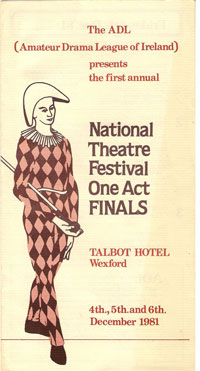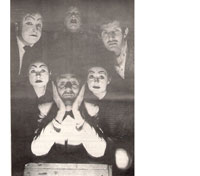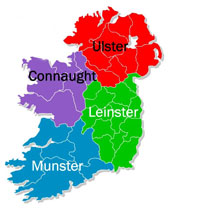History of the One Act Festivals
The One Act Drama Festival is run as a National Circuit every year in October and November. Local festivals run Open and Confined sections, where more experienced and newer groups to the competition are judged separately. Performances are evaluated and winners are selected by Adjudicators approved by the Joint Committee of the Drama League of Ireland and the Amateur Drama Council of Ireland. The competition evaluation criteria are based on an approved marking system and the highest marked festivals qualify for the All Ireland Finals.

The period covered by the history presented here is from 1981 up to the present day. In that thirty six years, while the Festival has been run in its present form, it has seen the world around it change utterly in some respects. In other ways, the ups, downs, quirks and foibles of human nature, the stuff of great drama, ensures that life and the essence of the Festival remain just the same!
History Outline with Full List of Festival Venues and Winners
A brief outline of the history of the One Act Circuit is in the PDF document below together with a list of All Ireland One Act Finals Festival Venues and Winners from 1969 to 2016. It was prepared by Óran O'Rua in consultaion with several of the many people who have contributed to the life and development of the Festivals over the years.
What follows is an abridged version of that story, but also an opportunity to see more of the older material used in its compilation to give a flavour of the times along the path that brought us to Dundrum this year.
Way back when 1 & 3 were 2 together!

Looking back even further than the last thirty years, there was a vibrant One Act Circuit in the 1960s and 1970s. In those decades, the One Act Festivals were organised with the Three Act Festival Circuit. The goal was to get to one common Finals Festival, which was held every year in Naas, County Kildare. Drama groups competed for a chance to stage their One Act plays with and against the Three Act shows. When viewed from today's perspective, that was a tough challenge, but it survived well into the 1970s.
However, as the 1980s approached, participation in the One Act Circuit declined to fewer than ten nominating festivals.
The first All-Ireland Finals, dedicated to One Act plays, were held in Talbot's Hotel, Wexford, in December 1981. This established a format that was to develop into the competition that enters its 36th year in 2016, marked by the All Ireland One Act Finals Festival in Dundrum.
Freedom and flexibility lead to Festival growth
Greater flexibility in the choice of venue allowed more groups in more places to be considered for a nominating festival. No longer confined to the formal facilities of a theatre, festivals flourished in hotels and in some cases, the lounge bars of larger pubs. The rules set limits designed to keep the staging simple and the cost of participation as low as possible. In a further effort to contain cost and therefore make the competition more accessible, it was agreed that there would be only three awards, given at the adjudicator's discretion.

The result was a reinvigorated One Act Festival Circuit that has brought us to the levels of participation and standards of performance we enjoy today.
The ADL continued to run a successful annual One Act Circuit until 1988, when Pegasus Drama Group (cast picture on the right), was the All-Ireland Winner with a performance of 'The Death of Pilate'. The One Act Finals continued to be held in various venues around the country from Carrick-On-Shannon one year to Carlow the next, Newcastle, County Down in another year and Mullingar.
One Act Circuit takes on a life of its own
As the One Act Circuit grew during the 1980s, an agreement between the Amateur Drama League of Ireland (ADL) and the Amateur Drama Council of Ireland (ADCI) divided the organisation of the three and one act circuits. The ADCI became solely responsible for the Three Act Circuit and a joint committee of the ADL and ADCI was setup to control the One Act Circuit.
The first joint ADL/ADCI Finals were held in The County Hotel, Carrick-on-Shannon in 1989. The ADL became the Drama League of Ireland (DLI) in the 1990s and went on with the ADCI to develop the competition into its current form.

From 1991 to the present day, the One Act Finals have been held in professional theatre venues around the country and run by local Festivals under the auspices of the Drama League of Ireland (DLI) and the Amateur Drama Council of Ireland (ADCI).
The second half of this 30 year history has seen the One Act Festival Circuit and Finals become more and more successful and popular with groups from all over the country, north and south of the border.
The venue for 2016 is also celebrating a significant historical milestone this year. Ten years after it was opened, the dlr Mill Theatre is delighted to open its doors and turn its stage over to the visiting groups. An enjoyable and exciting festival will be a fitting celebration of the long history and tradition of the One Act Circuit. As always, a behind the scenes 'army' will be working to help the best of the best compete for the coveted title of 'All-Ireland One Act Champion'.
Historical Timeline — The First Thirty Years
The timeline below takes a look back over the first 30 years of the One Act Festivals in their current form. It includes the venues that have hosted the Finals of the One Act Drama Circuit from 1981 up to 2010 - the Festivals, the venues, the plays, the groups and the people who charted the course of this history.
The scrollbar below the timeline allows you to scroll to an earlier date (left) or a later date (right). Clicking on the white left and right arrows on the scrollbar allows you to move in small increments. The orange 'year buttons' can be moved independently allowing you to change the earliest and latest visible date. The white numbers in the scrollbar display the minimum and maximum dates of the timeline.
-
Tips:
- The + and - on your keyboard also control zooming in and out.
- The < and > on your keyboard also control scrolling left and right.
- By moving your cursor over the timescale you can easily highlight items in the timeline.
- If you click on an item in the timeline, it will take you to the TimeRime website.
Gallery of Documents and Images
The material collected during the preparation of this brief historical perspective has been stored in a gallery of images on the Balally Players website using the 'SmugMug.com' image storage service. The collection has over 200 pictures, programmes and other details scanned from published documents. You can view the slide show here or visit the gallery by clicking on an image. From within the SmugMug gallery you can view the images in a range of sizes and download a copy of any image at the scanned or a lower resolution.
The Balally Players SmugMug account allows for the viewing and downloading of images at various sizes if high resolution pictures have been uploaded. The slideshow above can be run and stopped by clicking on the play (>) and pause (||) icons in the centre of the large image. You can move forward and back by clicking on the right or left of the image. To go to the gallery of these images stored in the Balally Players pages of the SmugMug site, double click on the main image above, where you can see and download larger copies of the images or visit www.balally.smugmug.com and go to 'One Act Festival History' in the galleries of available images.
Views from both sides
Over the years participants and Adjudicators have spoken and written about their views on the competition in general and their own experience in particular. The two articles below are taken from the gallery of documents and images. They are selected, not as examples of typical or even average views, but because they were written in the same year (2003), one by a very inexperienced performer and the other by a very experienced adjudicator.

A beginner talks about what she learned

An experienced judge talks about what to learn
"There is a lot of acting talent out there." says Adjudicator Billy Burns in the article above, "however I suggest that the director remains the key to any successful production." He refers to the Richard Burton quip that he quoted at the Virginia Finals "a director is just a trumped up stage manager". In acknowledging the "element of truth" in that, he goes on to say "but there's more to it than that. A play is first and foremost like a piece of music. It has distinct rhythms, ebb and flow, highs and lows. The director is the conductor, teasing out these rhythms, finding the pace, helping the cast to explore and mould the finished product. For make no mistake, the company will find it hard to do it alone."
As the Adjudicator has the last word on the night of the Finals, let's give the final thought to the 'beginner' above "We didn't get to the All Ireland but we will mull over our marks, the comments and the adjudications and decide where to go from here. If you have never experienced the one-act circuit, I would heartily recommend that you try it next year."





